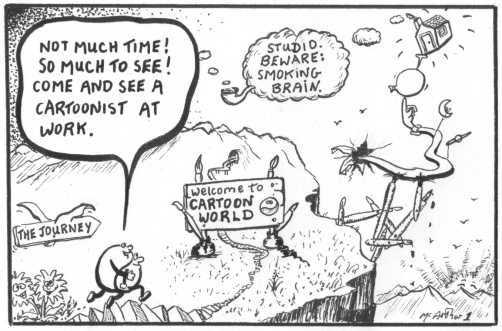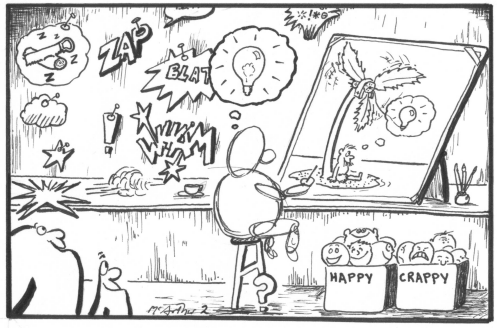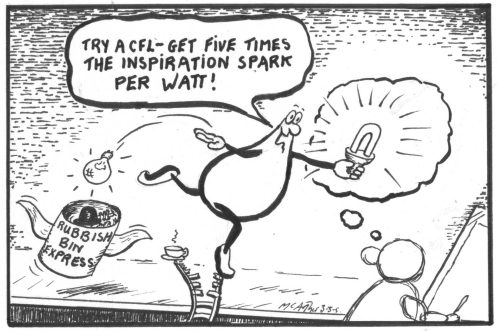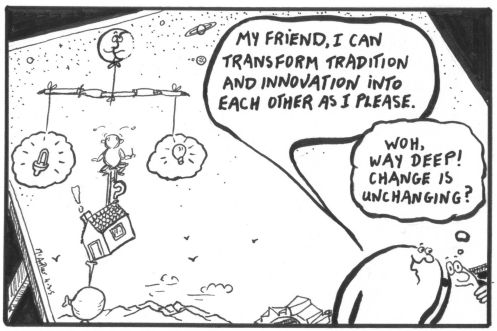|
Bonus Joules and the Knowledge Economy
|
|||||
|
|
Upgrading Cartoon Images Click on any cartoon Chapter Five - Land of the Other-Upsparking Inspiration.
Bonus Joules and the Knowledge Economy: All images on this site are copyright 2001 and you are free to use them with care.
Blog by Dave McArthur 14 October 2007
If you sniff something rotten about this whole carbon trading frenzy, know you are not alone. And the deal last week between NZ’s self styled “carbon neutral” Meridian Energy and Rio Tinto added to the pong. There are many reasons why I believe carbon trading is unsustainable. The main reason is the fact that it is based on profoundly flawed psychology. In brief, it is basically a mechanism for enabling people to deny their roles as stewards of our carbon potential. To my knowledge there is no substantial research in its psychological-educational impacts. Till then I will retain my hypothesis that carbon trading is the ultimate act of denial of personal responsibility and I let the national statistics of our carbon emissions be indicative proof. Till proof to the contrary is provided I will work on the assumption that carbon neutral =brain neutral However let us put these major
concerns aside and just look at the issue in terms of the narrow
framework that carbon trader’s operate in. These folk say something called The Market will provide the signals that will cause us to adjust our behaviour so we make more sustainable uses of our carbon potential. Last week our Prime Minister, Helen Clark, gave a speech at South Hampton University in Britain in which she suggested New Zealand is providing the world a sustainable model of how to behave and we are providing humanity with the most sophisticated carbon trading strategy yet It just so happened her speech coincided with one of the defining decisions of this century in New Zealand. A deal was signed between the Comalco Aluminium smelter (Owners: Rio Tinto 80%- Sumitomo Chemical 20%) and our largest bulk generator of electricity – the self-styled “carbon neutral” Meridian Energy. Meridian is a State Owned Enterprise (SOE) and is nominally owned by the New Zealand Government. In practice it is a vehicle for the bankers of the Bulk-generated electricity sector. The deal is top secret and so there no way you and I can discuss its implications in an intelligent way. We can only surmise how it has redefined New Zealand’s potential - especially our carbon potential. This much is known: the deal commits 15% of New Zealand’s current Bulk-generation capacity to Comalco for the period 2012-2030. That amounts to 572 MW of continuous supply. It will also be buying more, maybe 10% extra, as it needs under various other commercial contracts. To put all this into perspective, Comalco consumes the Bulk-generated electricity equivalent of over 550,000 households in New Zealand. That is over a one third of the number of households in New Zealand. And remember – carbon trading is all about signals that supposedly promote sustainable behaviour in the wider population so our gross carbon emissions are reduced. Meridian has 230, 000 customers and supplies about 30% of all New Zealand’s Bulk-generated electricity. Lets assume its website is accurate and it only employs generating plant that uses our hydro and wind potential. That means it supplies about all 60% of all our Hydro-dam and wind sourced Bulk-gen electricity. I am a Meridian customer because it is supposedly New Zealand owned, green and invests in ‘smart’ metering. And Greenpeace tells me to join it. And anyway I have little choice because our traditional local purchasing cooperatives are now effectively banned in New Zealand. Coincidentally Meridian offers the cheapest rates in the Wellington region where I reside. And I, ye common olde householder, am paying about 21 cents per kWh. This is no secret – my charges are published for the entire world to know. We cannot know what Comalco pays because it is top secret but it is safe to assume that it is under 7 cents a unit because the company had made it very clear it would build its own 600 MW thermal plant if it could not strike a deal with Meridian of under 7 cents kWh. That’s about a third of what we householders are paying. Now one of the things carbon trading is supposed to do is make accounting of our use of the resource transparent. How are we to know what deal has been struck with Comalco? For all we know 15% of our Bulk-generation sector is now completely insulated from Carbon Trade ebbs and flows for the next twenty-three years. What could this mean in practice? Well, while the rest of us are getting hit with carbon trade penalties the aluminium smelted by Comalco in New Zealand will exempt. And mineral oil could well be $US300 a barrel by then. First a little bit of history from Wiki In 1955
the modern history of Manapouri starts, when a geologist with Consolidated
Zinc Proprietary Ltd identified a commercial deposit of bauxite in Australia
on the west coast of Cape
York Peninsula, near Weipa.
It turned out to be the largest deposit of bauxite in the world yet
discovered. In 1956
The
Commonwealth Aluminium Corporation Pty Ltd, later known as Comalco,
was formed to develop the bauxite deposits. The company started
investigating sources of large quantities of cheap electricity needed to
reduce
the alumina
recovered from the bauxite into aluminium. Comalco settled on Manapouri
as that source of power and Bluff
as the site of the smelter. The plan was to refine the bauxite to
alumina in Queensland, ship the alumina to New Zealand for smelting into
metal, then ship it away to market. ….19
January 1960,
the Labour
Government and Consolidated
Zinc signed a formal agreement for Consolidated Zinc to build both
an aluminium smelter at Tiwai Point and a power station in Manapouri. ….1963,
Consolidated Zinc decided it could not afford to build the power
station. The New Zealand government takes over. Electricity generated by
the plant is sold to Consolidated Zinc at basement prices, with
no provision for inflation.” This was under a National Party Government. Since then both the smelter and the Manapouri Bulk-gen electricity scheme have been expanded. (See Think Big) Under both National and Labour Administrations Colmalco has
received most favourable treatment compared to that given the vast
majority of New Zealanders. Indeed it is only because of the action of a
group
of dedicated individuals There is much reason to believe this latest highly secretive deal is yet another massive subsidy to Rio Tinto- Sumitomo Chemical. And that the subsidy from New Zealand citizens will be used to promote destructive uses of humanity’s carbon potential. For instance, according to the TV3 "One of the biggest electricity consumers in the country has signed a secretive 18-year energy contract with the government-owned Meridian energy, but neither will say exactly how sweet the deal is." Comalco's
website suggests 86% of their product goes to Japan and other
countries. Similarly since the arrival of smelter in New Zealand in 1960 Comalco has played a powerful role in shaping the food and construction sectors of New Zealand as well as our general politics. As our
“Minister of Energy” David
Parker states "New
Zealand homes are poorly insulated and constructed compared to other
countries in the OECD.."
Our dwellings rate among the least efficient in the OECD and infrared imaging reveals them as thermal shacks. In recent decades individuals have attempted to remedy this. For instance, one person who began importing insulated metal frame windows and doors from Europe in an effort to raise standards here. He told me how the aluminium industry banded together and pulled in the unions, scaring them with stories that people like him threatened all their workers’ jobs. A special aluminium industry conference was held to counter the “threat” to the industry and it resulted in a deputation being sent the then Minister of Commerce. He apparently obliged them by placing an 18% tariff on imported insulated metal frame windows and doors. Our inefficient buildings, of course, generate extra demand for the construction of thermal plant to generate electricity at times of peak load. New Zealand’s carbon emissions from Bulk-generated electricity have rocketed as a result. Presumably with the advent of carbon trading Jo Citizen, sitting in their leaky home, will soon be paying extra carbon penalties when they buy Bulk-generated electricity to keep warm or cool in future. When I was young, pre-Comalco, our lunches were wrapped in wax paper and our breakfast oats came in re-usable cotton bags. Now they are wrapped in aluminium foil. As kids we scoured the countryside for sugar drink and beer bottles so we could claim the return bounty on them. And when we got older we took our faithful old half-G (half gallon glass bottle/jar) to the pub for a refill with beer or sherry. Now our supermarket checkouts are full of people carrying boxes of aluminium cans of beer and aluminium bags containing potato chips. A large portion of that smelted metal will end up in tips. And so here we have another source of subsidised carbon emissions, paid for by New Zealand citizens the length of the nation. As mentioned, already the price I pay for Bulk-generated electricity is rocketing compared to my income and I receive poorer service. I have just found a 2001 summer bill: the unit price =7.85 cents and lines charge was 70 cents a day. The lines charge even then represented a doubling in charges for a dwelling connection since the Electricity Reforms of the mid 1990s. Now my 2007 unit price = 19.93 cents with my total bill coming in at 21.66 per kWh (the lines charge is not identified now). I notice I was paying 27cents a kWh on my summer consumption this year. Now I know New Zealand led the charge in letting something called The Market determine how we use our carbon potential. I have read the accounts of Bill Clinton’s personal negotiator at Kyoto in which she describes New Zealand’s pivotal role in committing nations to carbon trading rather than carbon tax structures. And I have heard our negotiators talk with pride of their pivotal role. I have also sat through NZ Government briefings and heard them assure our business leaders "no worries, its business as usual" because we are fortunate that NZ is lucky to be in a powerful credit position because of our large forests. At the same time I watched our forests shrink after Kyoto as the carbon trading ethos destroyed agricultural wisdom. Then I watched those fancy "carbon credit" calculations turn to custard because our policy wonks did not know the value of many of our trees such as our native Manuka. Whoops! Suddenly our carbon credit reversed a $NZ1 billion or much more and we became a nation of carbon debtors with the cost to be paid for by taxpayers. And now I watch more forests being cut down and the land turned over to dairy farming. And as I pull my rug tight around me to keep warm in my 12 C room on this spring morning and witness my fellow citizens left struggling because of the inflation caused by our nation’s addictive use of mineral oil and Gas I wonder whether our rich elite will ever cherish and put a value on carbon as befits a most precious gift and heritage? At present it is not likely. You see, “the smartest guys in the room” have latched on to how they can use carbon to siphon off wealth. I read in the New York Times last week:
…
Carbon traders say emissions permits could become the world’s largest
commodities market if developed economies agree to take part in
second-phase Kyoto negotiations, to be held in Bali, Indonesia, in
December.”
Anyone who saw their troops trading in Enron might well experience shivers down their spine, if not experience very cold feet. At the same time I read this article: Big
Banks Are Selling Us Out on Climate Change “…Citi currently holds the title as the world's largest bank and biggest company. A few years ago, they also were leading the way in addressing environmental and human rights concerns in their industry. As RAN details in their new report "Banks, Climate Change and the New Coal Rush": In May 2007, Citi pledged to "direct $50 billion over the next 10 years to address global climate change through investments ..." Financing for renewable energy, energy efficiency and improvements in energy infrastructure amount to $31 billion spread across 10 years. While this may seem like a significant commitment, it amounts to less than 0.2 percent of the company's $2.2 trillion in assets. What is Citi doing with the other 99.8 percent? The answer to that question is that Citi has been busy funding dirty energy. Last year they gave 200 times more money for dirty energy than for clean. In the process they've helped underwrite some of the world's worst environmental and human rights offenders. Here's a sample: …..Bank of America is
not far behind Citi. It has also pledged to become an environmentally
sustainable business, but it doesn't seem to walk its talk. Last year it
spent 100 times more on dirty than clean energy, and it gives less than
0.2 percent to helping fight climate change…” It clear to me that if our Government policy tronks (I am trying to find a word to describe our trading wonks who believe something called the Market will sustain us) do not even know that the manuka tree is wood then they are babes in the jungle in the context of these brutal banking interests. What else have they miscalculated that small consumers of Bulk-electricity will have to pay for in carbon trading? I no sooner asked this question than up pops this article: Hydropower Doesn't Count as Clean Energy By Sarah
Phelan, Earth
Island Journal. Posted October
5, 2007. According to recently published estimates from Ivan Lima and some
of his colleagues at Brazil's National Institute for Space Research, the
world's 52,000 largest dams release 104 million metric tons of methane
annually. If Lima's calculations are correct, then dams would account
for about four percent of the total warming impact of human activities
-- and would constitute the largest single source of human-related
methane emissions. As Lima points out, if methane released from reservoir surfaces, spillways, and turbines were taken into account, India's greenhouse emissions could be as much as 40 percent higher than its current official estimates….
… According to Fearnside, if degassing emissions were factored in at several large hydropower plants in Brazil, then these dams would be larger contributors to global warming than their fossil fuel counterparts. To be precise, Fearnside suggested that during the first decade of its life, each of these dams would emit four times as much carbon as a fossil fuel plant that makes the same amount of electricity… … Noting that methane emissions from dams has not surfaced as a
major concern in temperate areas of the US, Dixon adds, "But it's a
big issue for the World Bank."
"It means that at least the very worst, dams are not going to get carbon credits," says McCully, noting that 400 dams have applied to receive carbon credits under the CDM, and that half of all these dams are in China. The article is clear that there is much debate. It also throws up the intriguing thought that it might be possible to capture the methane and burn it to save building still more dams. What if our tronks have got this calculation wrong too? Should I buy an extra rug now so I can survive with the future probable increases in my contribution to the Government enforced subsidies through the Bulk-generated electricity companies to Comalco and Japanese carmakers? My dream that the New Zealand Government would lead the world in promoting investment in our solar potential and in the insulation our dwellings is fading fast as this uncaring Market ethos is bedded in by our Parliament. Yes, all our political parties, including the Green Party, think carbon trading is a step in the right direction. Their clear subtext is that it is OK to abuse our carbon potential as long as you can find some idiot to pay for the mess you create. And if that means unresisting monks in Myanmar have their heads smashed against the stone walls of their monasteries for protesting that the cooking fuel of peasants has risen 1800% in two years so we can drive around in cars and flit around in planes, so be it. It’s just The Market at play. I suspect that the last thing on the minds if those monks as they lay dying in great pain was the thought that they are “offsetting carbon” and becoming “carbon neutral”. And when New Zealanders are rioting in crazed withdrawal because our addictive use of mineral oil is costing us $US150 a barrel I doubt they will be placated by a few wads of carbon trading calculations. What exactly will “The Market signals” be telling us then? I challenge you to allay my concerns and show me how the secretive Comalco deal is not definitive proof that carbon trading is unsustainable, to say the least. After all New Zealand is supposed to be the exemplar model of trading. On a positive note I heard a BBC programme on the future of cars this week. The presenter was looking down on a California “freeway” and describing how it was more a car park than a motorway. He observed that spending your life sitting idle in a jam of cars like this is rather a strange notion of freedom. He also observed that once people would have thought it their born right to use carbon this way but now increasing numbers of people are feeling guilt about it. I have noticed this too. For years I could not tell people why I do not fly or own a car because that was to invite scorn and dismissal. Now the great wheel of life is turning and I can more freely explain that I do not think it is wise and there is no need that I drive around in cars and fly in jets. Now people just tend to look thoughtful. Even more humbling, I am finding some young people congratulate me and even thank me. I am reminded of the great strength and wisdom that resides in most people’s hearts and this gives me hope that we will survive despite the carbon traders who would make our world Mad Max. The Bonus Joules
cartoon that accompanies this blog was first published about four years
ago. On several occasions I challenged cartoonists, graphic designers,
publishers and educators as to why they insisted on using the
incandescent light bulbs as a symbol for a bright idea when compact
fluorescent lamps are a five times brighter idea. In once case one of
New Zealand’s Government ministries published an “energy
efficiency” booklet, which featured one of our native birds with a
bright idea thought bubble containing an incandescent bulb. The bird is
telling children to buy CFLs! The most common
response of users of this symbol is that is it a traditional
representation of a bright idea and people “know what it means”. My only comment
is: “We are our symbols – we live and die by them for all is
change”. |
|
|||




